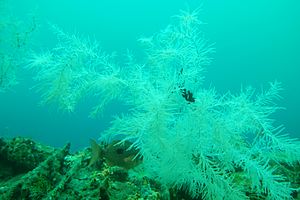Antipathella fiordensis facts for kids
Antipathella fiordensis is a special type of coral known as a black coral. It gets its name because its hard inner skeleton is black! This coral lives in groups, forming big, bushy or tree-like shapes. It was first found and described in 1990 by a New Zealand scientist named Ken R. Grange. He discovered it in the deep, steep-sided fiords of Fiordland, which is in the southern part of New Zealand's South Island. Later, scientists gave it a new scientific name, Antipathella fiordensis.
Quick facts for kids Antipathella fiordensis |
|
|---|---|
 |
|
| Antipathella fiordensis (pale) with a basket star (dark) in one of its branches | |
| Conservation status | |
|
Invalid status (NZ TCS)
|
|
| Scientific classification | |
| Synonyms | |
|
Contents
What Does the Black Coral Look Like?
Black corals can look like flexible bushes or small trees. They have black, strong skeletons covered by a thin layer of living tissue. Tiny creatures called polyps stick out from this living layer. Each polyp has six tentacles that don't branch out, and a mouth shaped like a slit. These polyps cannot pull themselves back into the coral.
Most of the time, the tentacles are very small, less than 2 millimeters (about 0.08 inches) long. But this black coral can grow special "sweeper tentacles" up to 15 millimeters (about 0.6 inches) long. These longer tentacles have stinging cells. They seem to use them to stop other organisms from trying to grow on the coral's branches. Unlike some corals, A. fiordensis does not have tiny algae called zooxanthellae living inside it. This means it doesn't need sunlight to survive.
How Does the Black Coral Reproduce?
Male and female A. fiordensis corals are found in equal numbers. It's hard to tell them apart just by looking. These corals don't start having babies until they are quite old and big, usually about 0.7 to 1.0 meter (2.3 to 3.3 feet) tall. This means they are at least 30 years old! Female corals can produce a huge number of eggs, from 1.3 million to almost 17 million, every year.
Where Does the Black Coral Live?
Antipathella fiordensis lives in the ocean around New Zealand. You can find it at depths from 5 meters (about 16 feet) down to 100 meters (about 328 feet).
Who Lives With the Black Coral?
The fiords where A. fiordensis grows have very steep rock walls. This means there aren't many places for sea creatures to attach themselves. Because of this, many other species choose to live on these black corals.
One interesting creature that lives with A. fiordensis is the snake star, Astrobrachion constrictum. This snake star sits on the coral and wraps its arms tightly around the branches. Snake stars are found in several places around New Zealand, but they are always living with a black coral.
It seems like they have a special partnership, called a mutualistic arrangement. This means both the coral and the snake star help each other. The coral polyps are better at catching food than the snake star's arms. The snake star takes some of this food. In return, the snake star helps the coral by cleaning off mucus and stopping other organisms from settling and growing on it.


